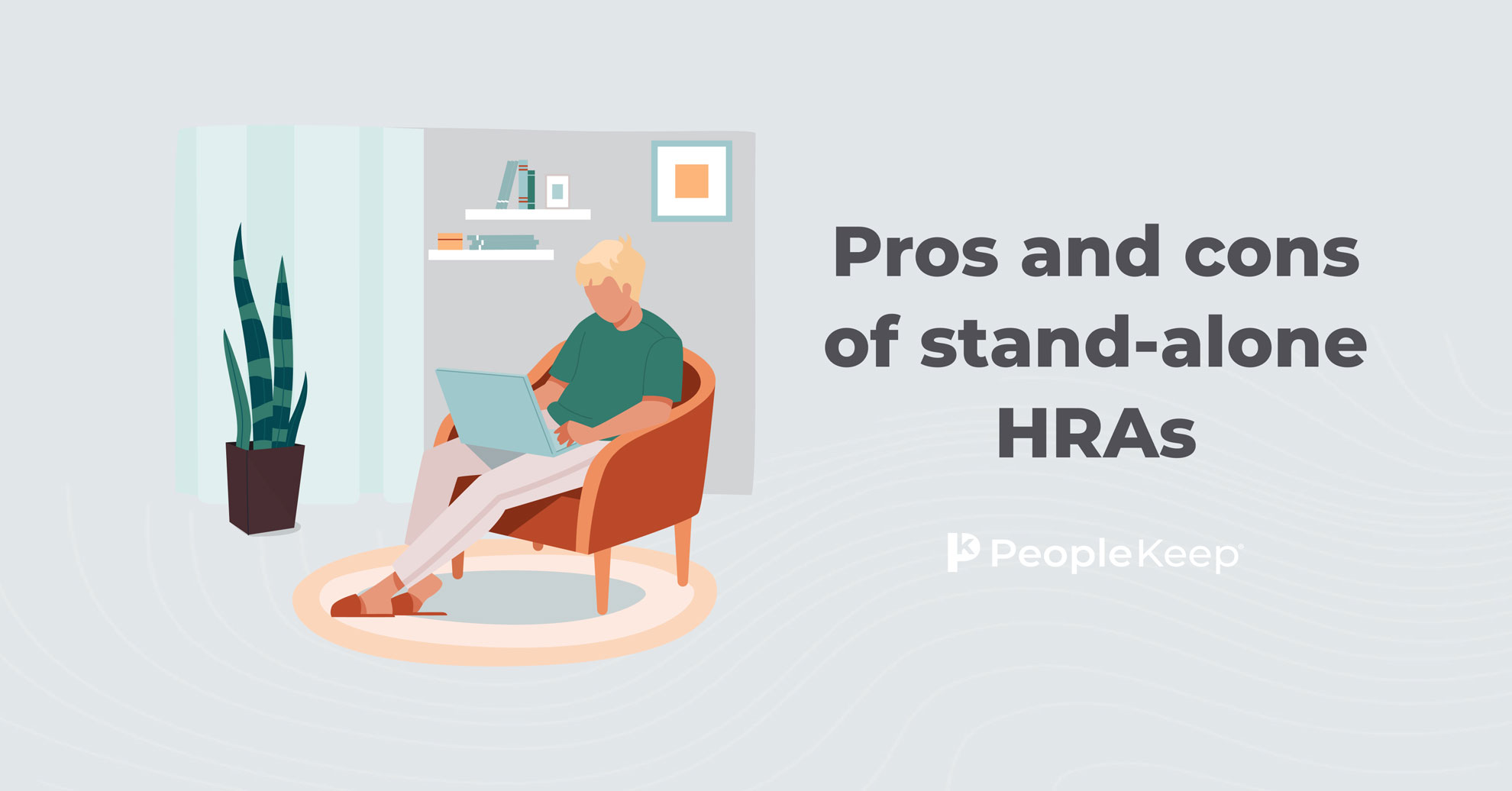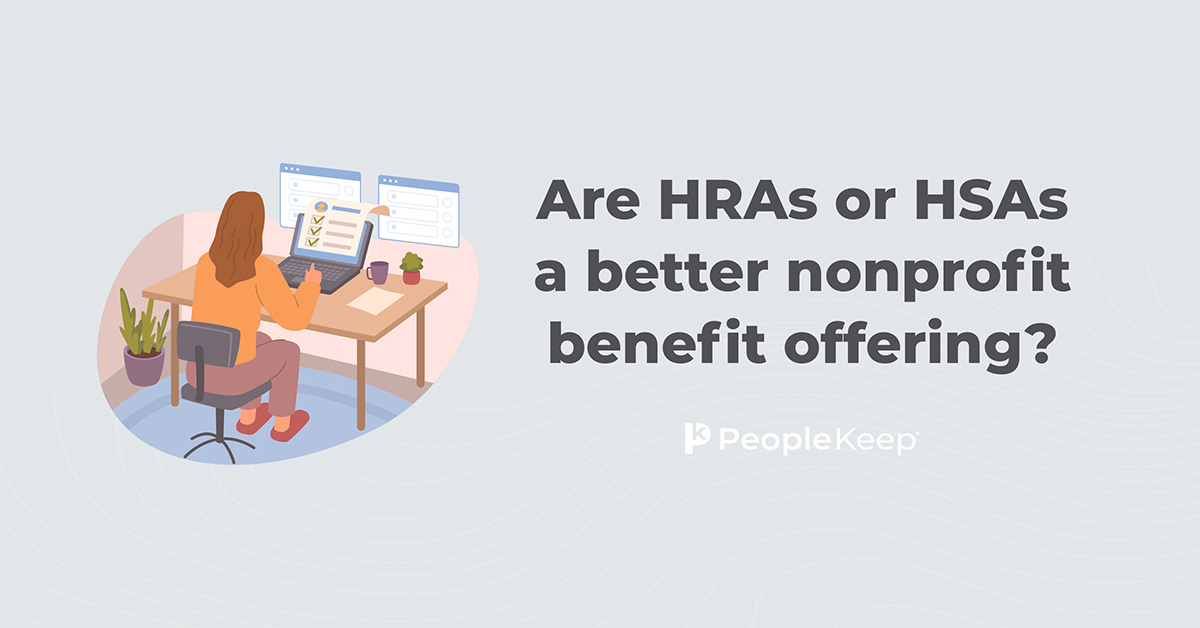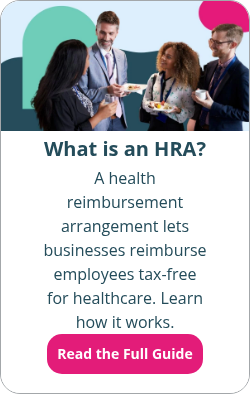Should I offer an HRA or HSA?
By Elizabeth Walker on July 21, 2025 at 8:00 AM
When researching employee health plans, it's easy to confuse different benefits with one another. Two commonly mixed-up benefits are health reimbursement arrangements (HRAs) and health savings accounts (HSAs).
While they have similar-sounding names, they differ in many ways. For example, who can participate, who funds them, and what type of health plan works for each benefit vary.
In this article, we'll cover the pros and cons of HRAs vs. HSAs and highlight their key differences. We’ll also show you how to use these two employee benefits together.
In this blog post, you’ll learn:
- How HRAs and HSAs compare.
- The disadvantages and advantages of HRAs and HSAs.
- How you can use an HRA and HSA at your organization.
Pros and cons of HRAs and HSAs
The biggest difference between HRAs and HSAs is how they work. An HRA is a reimbursement arrangement that allows employers to reimburse employees for qualifying expenses. An HSA, on the other hand, is a savings account where employees keep funds for future medical expenses.
That said, HRAs and HSAs have many advantages. According to KFF, nearly a quarter of companies offering health benefits offer an HRA, an HSA, or both1.
Firstly, there are tax advantages and financial benefits. HRAs and HSAs allow employers and employees to use pre-tax money to fund employee medical expenses. They also help offset rising medical care costs. For businesses, they save your organization money on your health benefits budget.
HRAs and HSAs have several key aspects in common. For example, they encourage employees to own their health by buying their preferred medical services and items. But both benefits have their ups and downs.
Understanding both plans' pros and cons can help you determine the right choice for your company. That way, you can build an employee benefits package that will entice employees.
HRAs vs. HSAs: Biggest advantages and disadvantages
|
HRA advantages |
HSA advantages |
|
|
|
HRA disadvantages |
HSA disadvantages |
|
|
Now that we’ve covered the advantages and disadvantages of each benefit let’s break down these two key benefits in more detail.
1. Plan ownership
HRA
HRAs are employer-owned health benefits. They're an arrangement between you and your employees — not an account. With an HRA, you provide a tax-free reimbursement allowance that your employees can use when they incur a qualified expense.
Examples of qualified expenses include:
- Dental and vision care
- Prescription drugs
- Certain medical equipment
- Other out-of-pocket medical costs
With an individual coverage HRA (ICHRA) or a QSEHRA, you can even reimburse your employees for their individual health plan premiums.
At the end of each year, or when the employee leaves your organization, unused funds stay with you.
Employees generally use their HRA while they're still employed. However, employees can still get tax-free reimbursements for qualified expenses with HRA money when they leave your organization. But they must do so within 90 days of leaving your company and only for eligible expenses incurred during employment.
HSA
Unlike an HRA, the employee owns an HSA. As its name implies, an HSA is a spending account that houses pre-tax dollars for future eligible healthcare expenses. Both you and the employee can fund the account. However, the employee owns it at their financial institution of choice. So, any unused funds in the HSA bank account will stay with the employee even after leaving your organization.
As a bonus, many employers offer HSA card-based solutions. This means employees can purchase healthcare using their HSA dollars with a debit card. But unlike a credit card, only certain vendors will accept an HSA card at the register.
2. Participation requirements
HRA
Only an employer can offer an HRA; it's not a reimbursement account that individuals can open independently.
Employees eligible for an organization's HRA include:
- A current W-2 employee
- A spouse of a current employee
- A dependent of a current employee
There are also specific participation rules for each HRA:
- An integrated HRA requires individuals to be on their employer-sponsored group health insurance plan.
- The QSEHRA requires employees to have a health plan with minimum essential coverage (MEC).
- The ICHRA requires employees to have a qualifying form of individual health insurance coverage.
Once they have the required coverage, they can receive HRA reimbursements for their health insurance premiums and other out-of-pocket eligible expenses.
Business owners can also participate if the IRS considers them a W-2 employee.
HSA
Employers can offer an HSA, or employees can open an account themselves at their preferred financial institution.
Eligible employees qualify for an HSA if they meet the following requirements:
- They enroll in an HSA-qualified high deductible health plan (HDHP)
- On July 3, 2025, Congress passed the One Big Beautiful Bill Act (OBBBA). As part of the Act, all bronze and catastrophic plans sold on public health exchanges also qualify as HSA-eligible HDHPs, even if they don’t meet the usual HDHP criteria3.
- They aren’t a participant in any other non-HSA qualified health insurance plan
- They're not eligible to use a general-purpose flexible spending account (FSA)
- Someone else doesn’t claim them as a dependent on their tax return
- They don’t have Medicare Parts A & B or a Medicaid plan
3. Contributions
HRA
HRA contributions can only come from the employer — employees can’t contribute. Depending on your type of HRA, there may be annual employer contribution limits. QSEHRAs and EBHRAs have annual maximum contribution limits, but ICHRAs and GCHRAs have no minimum or maximum contribution limits.
Because an HRA is a reimbursement tool, you pay for your employees' healthcare costs once they incur a medical expense. You reimburse employees up to your defined allowance amount.
HSA
Contributions to HSAs can come from both the employer and the employee. But, combined contributions can’t exceed the annual limit the IRS sets. Unlike an HRA, employer contributions happen at regular, organization-defined intervals regardless of whether an employee incurs a medical expense.
Suppose you have employees who are 55 or older. In that case, they can take advantage of catch-up contributions and add $1,000 more per year to their HSA.
4. Plan coverage
HRA
Depending on which type of HRA plan you offer and how you design it, employees can use their funds to cover their monthly health insurance premiums, an eligible medical cost they incurred as an out-of-pocket expense, or both.
IRS Publication 502 provides more details regarding eligible healthcare expenses, which costs aren’t qualified, and which expenses may qualify based on certain circumstances (such as a doctor's note or a prescription).
HSA
Employees can use their HSA for the same eligible healthcare expenses outlined in IRS Code Section 213(d) as an HRA4, except for premiums. Because HSA funds are portable, employees can use their HSA as a savings account to pay for non-medical expenses in the future. This means individuals can include their HSA dollars in their retirement savings to help them reach their financial goals.
However, if the individual has yet to reach age 65, the IRS will tax withdrawals if they use their HSA funds on non-qualified medical expenses. Therefore, participants must report these distributions on their tax returns to pay income taxes on the amount.
How HRAs and HSAs can work together
As an employer, you don't need to decide between these two employee health plans—you can offer both! This approach often provides the best value to employees. But you must meet specific requirements for employees to use both compliantly.
To meet HSA eligibility requirements, an individual must enroll in an HSA-qualified high deductible plan. The individual's other policies, including the HRA, must also be HSA-qualified.
The simplest way is to offer a "limited-purpose HRA”. This type of HRA only reimburses employees for health costs that are exempt from the HSA deductible requirement. Like a limited-purpose FSA, this type of HRA has a narrow focus, but employees can still use it for medical purposes.
The eligible medical expenses under a limited-purpose HRA are:
- Healthcare coverage premiums
- Long-term care premiums
- Wellness and preventive care, such as annual physicals, checkups, mammograms, smoking cessation, and weight loss
- Dental expenses, like orthodontia, diagnostic medical services, and dental plan deductibles
- Vision expenses, like eye exams, contact lenses, and LASIK surgery
A standard HRA type will make an employee ineligible for an HSA because it would provide health coverage for all medical expenses, including copays for prescriptions, which aren't exempt.
If you plan to offer an HRA through a provider, make sure they allow you to limit medical costs to these categories so you can comply with federal regulations.
Conclusion
While HSAs and HRAs are similar employee health benefits, they have different advantages and disadvantages. Understanding how each benefit works before making an informed decision about one or the other at your company is critical.
Whether you offer an HRA, an HSA, or both, these types of health benefits will help them pay for their medical care and have tax benefits. But, an HRA may provide more flexibility for your employees. If an HRA makes sense for your organization, PeopleKeep's HRA specialists can help. Schedule a call, and we'll get you started!
This article was originally published on March 18, 2020. It was last updated on July 21, 2025.
Check out more resources
See these related articles

Pros and cons of stand-alone HRAs
Stand-alone HRAs can offer flexibility and control over healthcare expenses, allowing employers to customize plans to meet their employees' needs.

Are HRAs or HSAs a better nonprofit benefit offering?
HRAs vs. HSAs: Which nonprofit benefit option should you choose? Dive into this article to see the differences and make the best decision for your organization.

How to tell if your HDHP is HSA-qualified
Not sure if your high deductible health plan is HSA-qualified? This article explores how to determine if you're eligible for a health savings account.



